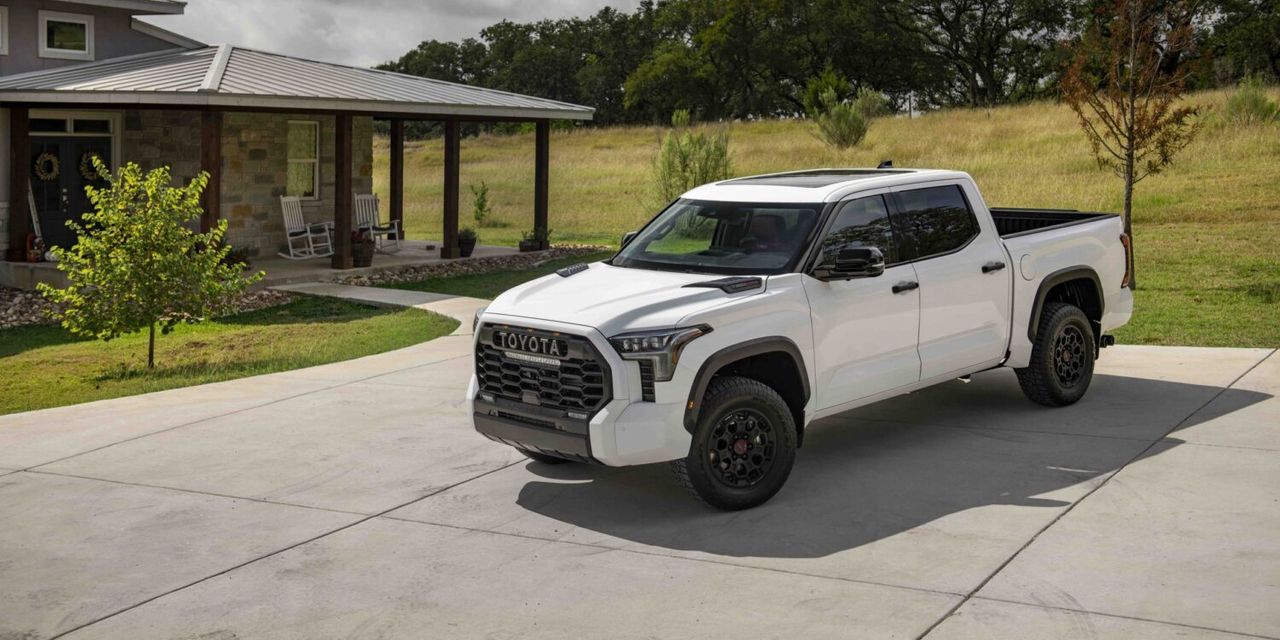If you haven’t already, you will need to face the reality of buying a vehicle with some degree of electrification, probably sooner rather than later.
There are electrified opportunities aplenty for those looking for a car or SUV. However, electrified options for pickup truck shoppers are uniquely limited. That’s not overly surprising because pickup truck owners are notoriously averse to change. Furthermore, for those who use their truck for real work, fully electric trucks don’t measure up to the capabilities and convenience of gas-powered pickups.
In addition, EV trucks cost thousands more than their internal combustion engine, or ICE, counterparts. For example, the entry-level EV Ford
F,
F-150 Lightning Pro has a base price of just shy of $50,000. This is roughly $16,000 more than the ICE base F-150 XL.
The electric Ford F-150 Lightning Pro, with a “frunk” in front.
Ford
All things considered, the argument for a hybrid truck over an EV truck is persuasive. However, the case for buying a hybrid truck over one with an ICE isn’t nearly as convincing. Let’s take a closer look and see if a hybrid pickup is worth it for you.
What is a hybrid truck?
A hybrid truck uses some combination of an internal combustion engine and an electric motor fed by a battery to create propulsion. There are basically three kinds of hybrid systems: HEV (regular hybrid), PHEV (plug-in hybrid), and MHEV (mild hybrid).
HEV
HEV is the acronym for a traditional full hybrid gas and electric system like that in a Toyota
TM,
Prius. Unlike full-blown electric trucks, hybrid trucks can stretch a truck’s mileage and improve performance without a bloated price tag, range concerns, or the inconvenience and time suck of plug-in EV charging.
Parallel HEV
Typically, with a parallel HEV system, its ICE and electric motor share the work to rotate the drive wheels. However, both the ICE and the motor can power the wheels independently. When accelerating from a stop, the electric motor can often propel the vehicle for short distances at speeds below 15 mpg or so. At higher speeds, the ICE kicks in. When needing an extra burst of speed while already cruising, the motor and internal combustion engine work together to create the energy boost.
The hybrid battery is charged primarily by energy captured from the vehicle’s brake system (regenerative braking). Plus, some engine energy is siphoned off to the battery when the vehicle is cruising. A parallel system’s advantage over a series HEV is a smaller battery and a lower price.
Series HEV
Where a parallel HEV system has an electric motor and ICE that can operate independently or in concert with one another to provide propulsion, a series hybrid uses an electric motor alone to power the wheels. An internal combustion engine supplies the electric power to fuel the generator or charge the battery, which feeds the electric motor. Regenerative braking also helps feed the battery. Think of the Chevy Volt.
MHEV
We’ll touch on mild hybrid systems because, although fairly common in cars and SUVs, they only sporadically appeared in trucks. However, nearly every new Ram 1500 truck sold today has a mild hybrid powertrain. They use a very small battery to help the ICE out by taking over the operation of some electrical components, particularly when engines with automatic stop-start cut engine power. The mild hybrid then assumes the task of maintaining power to systems like air conditioning. When considered as a part of the entire fuel-saving scheme, MHEV systems help increase fuel economy by up to 15%.
PHEV
Currently, you need not concern yourself with plug-in hybrids when truck shopping. There are no PHEV pickup trucks, or at least not yet. Ford has a PHEV Ranger in the pipeline, but we probably won’t see it until 2025, if at all. A PHEV offers a larger battery than an HEV and can travel 25 miles or more at any speed on battery power alone. Charging the battery pack requires plugging into an outside electric source, which can be a 110-volt household outlet or a 240-volt outlet like your electric range uses via a Level 2 charger.
Learn more: What is EV, BEV, HEV, PHEV? Here’s your guide to types of electric cars
List of 2024 hybrid trucks
The pickings are relatively slim for hybrid trucks in 2024. We’ve put together the shortlist to fast-track your search. You can expect more hybrid trucks to populate this selection with time.
- 2024 Toyota Tundra i-Force Max – An HEV, it produces a whopping 437 horsepower and 583 lb-ft of torque. It can tow up to 11,350 pounds and carry a payload of more than 1,600 pounds. Its estimated combined mileage with rear-wheel drive (RWD) is 22 mpg. Base price: $57,625.
- 2024 Ford F-150 PowerBoost – A traditional HEV, the F-150 PowerBoost delivers a combined 430 hp and 570 lb-ft of torque. The towing capacity estimates are around 12,700 pounds, with a payload limit estimated at more than 3,000 pounds. There are no estimated fuel economy numbers yet. Base price (Lariat): $64,995.
- 2024 Ram 1500 – Nearly every Ram model comes with Ram’s eTorque MHEV technology. The V6 and smaller V8 are MHEV powertrains. The V6 eTorque produces 305 hp and 271 lb-ft of torque. It can tow 7,690 pounds with a maximum payload of 2,300 pounds. Its government-estimated combined fuel economy is 22 mpg. Base price: $38,570.
- 2024 Ford Maverick – Every Maverick model offers a 2.5-liter hybrid option. Because it’s a compact truck, the hybrid towing, payload, and price are far below full-size hybrids. It generates 191 hp and 155 lb-ft of torque. It can tow up to 2,000 pounds with a top-end payload capability of 1,500 pounds. The government estimated combined mileage is 37 mpg. Base price: $24,900.
See: Ford’s new Maverick hybrid truck is a cheaper alternative to hulking pickups
What about EV Trucks?
In the great scheme of transforming our national vehicle fleet from internal combustion engine-powered to fully electric vehicles, the transitioning of trucks is a less-than-inspiring success. Generally, any arguments against EVs are tremendously magnified when the discussion turns from cars and SUVs to trucks. That’s not to say there aren’t examples of EV trucks; there certainly are. The Rivian
RIVN,
R1T and Ford F-150 Lightning immediately spring to mind. Such EV trucks perform adequately enough when functioning as mere transportation. In other words, as with EV cars, they mostly perform as advertised when simply ferrying around a driver and a passenger or two.
The Rivian R1T
Rivian
However, have one pull an 8,000-pound trailer or haul around 1,000 pounds of payload in the bed, and the range drops like a rock. That is, the estimated range doesn’t hold up to real-world experience when an EV pickup is employed doing, well, actual work. You know, like trucks are supposed to do.
You don’t need to take my word for it. In June 2023, AAA released its findings on the effects of hauling 1,400 pounds of cargo in the bed of an F-150 Lightning. The result: The range dropped more than 24% from 278 miles to 210 miles. Ford says the Lightning can tow up to 10,000 pounds. What impact would that have on the estimated range?
PRO TIP: Given today’s battery technology, I am willing to stick out my neck and say there is a better alternative to an EV truck that manages to conserve fossil fuels, lower emissions, increase performance, and work as hard — or harder — than an ICE truck. Yep, you guessed it: a hybrid truck.
From the archives (2020): Americans’ love affair with pickup trucks might be derailing their retirement plans
Advantages of hybrid trucks over EV trucks
Although hybrids are typically more expensive than their ICE counterparts within a brand, currently, only one real price comparison can be made between a brand’s comparable EV and hybrid. It is the Ford F-150 Lightning and the F-150 Hybrid. The entry-level Lightning trim is the Lariat. When comparing the 2024 prices of the Lightning Lariat against the F-150 Lariat Hybrid, the hybrid is roughly $7,000 less. Although the price difference amount will vary, the hybrid versus electric plays out in comparison after comparison, whether it’s with cars, SUVs, or our Ford F-150 truck example.
Read: The big problem with chargers that’s challenging electric car owners
As for towing, the Lightning with the regular range battery, reflected in our price comparison above, can tug 7,700 pounds. The F-150 Hybrid can tow 12,700 pounds. The payload maximums stack up as 2,000 pounds versus 2,455.
What about gas trucks?
Trucks with internal combustion engines remain stubbornly popular, whether comparing them to EV trucks or HEV trucks. Let’s go back to the Ford F-150. You can score an entry-level 2024 F-150 with a regular cab and the standard 5.0-liter V8 for $36,570. It can tow up to 13,500 pounds with a payload capacity of up to 3,325 pounds. Its government-estimated combined fuel economy is 22 mpg, compared with the hybrid’s 25 mpg.
But what if we examine an ICE configuration more in line with the F-150 Hybrid? The entry-level F-150 Hybrid is a Lariat with a SuperCrew Cab ($64,995). The F-150 Lariat SuperCrew with the standard 5.0L V8 ICE prices out at (wait for it) $64,995. This ICE version can tow up to 12,900 pounds and haul up to 2,900 pounds. Its government-estimated combined fuel economy remains at 20 mpg. The lack of sunshine between the ICE F-150 Lariat and the F-150 Lariat Hybrid prices is rare. Typically, a hybrid will cost somewhere between $1,000 and $3,000 more than a comparable ICE vehicle.
Pros and cons of hybrid trucks
Whether the comparison is between an EV truck or an ICE truck, it’s plain to see with the limited examples we have that the hybrid comes out pretty well. However, the more startling discrepancy is between a hybrid truck and an EV truck. Consequently, we’ll compare those first.
Pros of a hybrid truck vs. an EV truck
- Price – Where we can directly compare an EV with an HEV, the HEV will always be more affordable by thousands of dollars.
- Range – Range isn’t a real factor with a hybrid because there is an ICE backing up the battery-fed electric motor. However, in the case of the F-150 hybrid, the range is roughly 700 miles between fuel stops. The estimated range for the F-150 Lightning example I’ve used here is up to 230 miles. Moreover, that’s without a load. Loading an HEV truck or attaching a trailer will also reduce its range, but that reduction won’t have anywhere near the impact it does with an EV.
- No charging – Unlike an EV that must be charged via an electric source, an HEV is self-charging. In other words, it doesn’t require the hours required to secure an available charger and replenish the battery.
- Capability – In our one direct example, the F-150 PowerBoost hybrid has capabilities similar to the ICE F-150, which are far better than the F-150 Lightning.
Cons of hybrid trucks vs. EV trucks
- Power delivery – No matter what the torque numbers are, a hybrid requires more time to deliver its maximum torque than an EV, in which the maximum torque is immediately available. Moreover, EVs tend to offer higher horsepower and torque than comparable hybrids.
- Higher fuel costs – Driving the same amount of miles per year, it costs more to operate a hybrid than an EV. Comparing the F-150 Lightning and the F-150 Hybrid, the average cost difference is $1,550 per year, according to the EPA (Environmental Protection Agency).
- Higher emissions – According to the U.S. Department of Energy, a hybrid produces roughly 50% of the emissions of an ICE vehicle, and an EV emits zero tailpipe emissions.
- Maintenance costs – Because EVs don’t have as many mechanical moving parts, their routine maintenance costs are lower.
Pros of hybrid trucks vs. internal combustion trucks
- Fewer emissions – As stated above, a hybrid produces roughly 50% fewer tailpipe emissions than an ICE vehicle.
- Lower fuel costs – When comparable, a hybrid gets a bit better fuel economy than an ICE vehicle, with an EPA annual estimated savings of $250 per year.
Cons of hybrid trucks vs. internal combustion trucks
- Price – In the case of the F-150 PowerBoost Hybrid and the ICE F-150, we can’t make this statement because there’s no cost difference. However, typically, hybrids cost more than comparable ICE vehicles.
Are hybrid trucks worth it?
When compared to EV trucks, hybrid trucks are well worth it. They basically do the same level of work as an ICE truck while producing half the tailpipe emissions, yet cost thousands less than a less capable EV truck.
Typically, hybrids cost more than comparable ICE vehicles. However, where trucks are concerned, entry-level hybrids are more expensive configurations and trims than entry-level ICE trucks. Consequently, you can find a lower-trim ICE truck that costs thousands less than the current hybrid offerings that can handle similar towing and payload limits.
My advice is to consider a hybrid if your heart is set on an electrified truck. The HEV truck is certainly worth it in that scenario. The decision becomes tougher when picking between an HEV truck and an ICE truck. In the case of the Maverick Hybrid, the fuel savings over the ICE version are substantial. It’s not so clear-cut when talk turns to the F-150 PowerBoost or Tundra i-Force Max.
Do hybrid trucks get better gas mileage?
Hybrid trucks do get better gas mileage than those with internal combustion engines. In the case of the Toyota Tundra i-Force Max HEV, the difference is 2 mpg. Looking at the Ford Maverick Hybrid, its advantage over the ICE version is 13 mpg.
Read: The pros and cons of plug-in hybrid cars and your guide to buying one
How much does a hybrid truck cost?
Currently, the available four hybrid truck models as of this writing range in price from the $24,900 Ford Maverick to the $64,995 Ford F-150 PowerBoost hybrid.
This story originally ran on Autotrader.com.
Read the full article here










